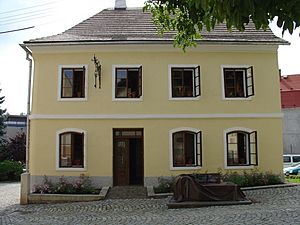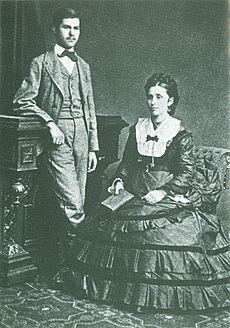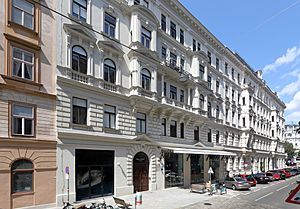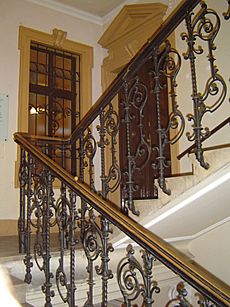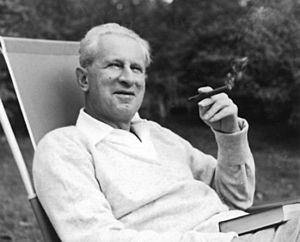Sigmund Freud facts for kids
Quick facts for kids
Sigmund Freud
|
|
|---|---|
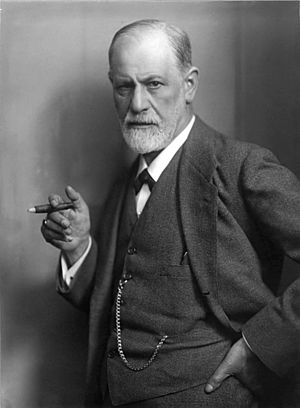
Freud c. 1921
|
|
| Born |
Sigismund Schlomo Freud
6 May 1856 Freiberg in Mähren, Moravia, Austrian Empire (Now Czech Republic)
|
| Died | 23 September 1939 (aged 83) Hampstead, London, England
|
| Alma mater | University of Vienna (MD, 1881) |
| Known for | Psychoanalysis, including the theories of id, ego and super-ego, repression, defense mechanism |
| Spouse(s) | |
| Children | Mathilde, Jean-Martin, Oliver, Ernst, Sophie, and Anna |
| Parents |
|
| Awards | Goethe Prize (1930) |
| Scientific career | |
| Fields | Neurology, psychotherapy, psychoanalysis |
| Institutions |
|
| Academic advisors |
|
| Influences | |
| Influenced |
|
| Signature | |
Sigmund Freud (pronounced FROYD; born Sigismund Schlomo Freud; 6 May 1856 – 23 September 1939) was an Austrian neurologist. He is famous for founding psychoanalysis. This is a way of understanding and treating mental health problems. It involves talking between a patient and a psychoanalyst. Freud also developed a special theory about how the human mind works.
Contents
Sigmund Freud: A Pioneer of the Mind
Early Life and Education
Sigmund Freud was born in 1856 in Freiberg, a town in the Austrian Empire. He was the first of eight children. His parents were Ashkenazi Jews. His father, Jakob Freud, was a wool merchant. His mother, Amalia Nathansohn, was 20 years younger than his father. They faced financial struggles when Sigmund was born.
In 1859, Freud's family moved from Freiberg. They first went to Leipzig and then to Vienna in 1860. In Vienna, four more sisters and a brother were born. At age nine, Freud started high school. He was an excellent student and graduated with honors in 1873. He loved literature and knew many languages. These included German, French, Italian, Spanish, English, Hebrew, Latin, and Greek.
Freud began studying at the University of Vienna when he was 17. He first planned to study law. However, he joined the medical faculty instead. His studies included philosophy, physiology, and zoology. In 1877, he worked in a physiology lab. He spent six years comparing the brains of humans and animals. His research on nervous tissue was important for discovering the neuron later on. Freud finished his medical degree in 1881.
Starting His Medical Career
In 1882, Freud started working at Vienna General Hospital. For three years, he worked in different hospital departments. He became very interested in helping patients with mental health issues. In 1885, he became a university lecturer in neuropathology. This allowed him to give lectures at the University of Vienna.
In 1886, Freud opened his own private practice. He focused on "nervous disorders." That same year, he married Martha Bernays. They had six children: Mathilde, Jean-Martin, Oliver, Ernst, Sophie, and Anna. From 1891 until 1938, Freud and his family lived in an apartment at Berggasse 19 in Vienna.
Freud read many important books. These included works by Charles Darwin and Eduard von Hartmann. He was also influenced by thinkers like Gustav Fechner and Johann Friedrich Herbart. He found some similarities between his ideas and those of Arthur Schopenhauer and Friedrich Nietzsche. Freud also read William Shakespeare throughout his life. His understanding of people might have come partly from Shakespeare's plays. His Jewish background also shaped his thinking.
Developing Psychoanalysis
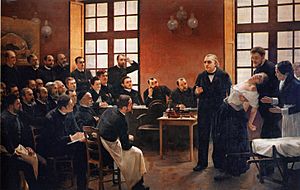
In 1885, Freud went to Paris for three months. He studied with Jean-Martin Charcot, a famous neurologist. Charcot studied hypnosis and hysteria. This experience helped Freud decide to focus on mental health treatment.
When he returned to Vienna in 1886, Freud started using hypnosis in his practice. He worked with his friend Josef Breuer. They treated a patient known as Anna O.. She would talk about her symptoms while under hypnosis. She called her treatment the "talking cure." Her symptoms improved as she remembered difficult events.
Freud later stopped using hypnosis. He found that patients got better results by talking freely. He called this "free association." He also found that analyzing dreams could reveal hidden thoughts. By 1896, he used the term "psychoanalysis" for his new method.
Freud developed his theories during a difficult time. His father died in 1896. This led him to analyze his own dreams and childhood memories. He explored his feelings about his parents. This helped him change his ideas about how mental problems begin.
In 1895, Freud published Studies on Hysteria with Josef Breuer. In 1899, he published The Interpretation of Dreams. In this book, he explained how dreams show our hidden wishes. He also described his model of the mind. He wrote other popular books like The Psychopathology of Everyday Life (1901). He also wrote famous case studies like the 'Dora' case. He studied obsessional neurosis and phobia in other cases.
Freud discovered a process called transference. This is when patients transfer feelings from past relationships onto their analyst. At first, he saw it as a problem. But by 1912, he realized it was a key part of therapy.
Spreading His Ideas
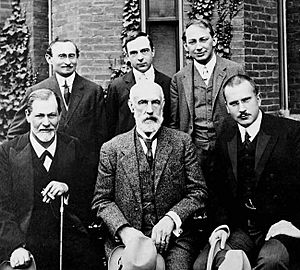
In 1902, Freud became a university professor. This gave him more recognition. He continued to give lectures on his work. In the autumn of 1902, doctors interested in his work began meeting at his apartment. This group was called the Wednesday Psychological Society. It was the start of the worldwide psychoanalytic movement.
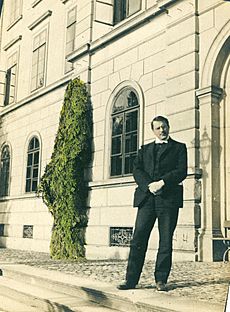
By 1906, the group had grown. Freud also started writing to Carl Jung, a Swiss psychiatrist. Jung and other Swiss doctors visited Freud in Vienna. They then started their own psychoanalytic group in Zürich. In 1908, the Wednesday group became the Vienna Psychoanalytic Society.
Freud's early followers met formally for the first time in 1908 in Salzburg. This was the first International Psychoanalytic Congress. Many important figures attended, including Ernest Jones from London. They decided to launch a journal for psychoanalysis. In 1910, they formed the International Psychoanalytical Association. Jung became its first president.
Freud wanted to spread psychoanalysis in English-speaking countries. He worked with Abraham Brill and Ernest Jones. Brill translated Freud's works into English. Jones helped establish Freud's ideas in North America. In 1909, Freud visited the United States. He gave five lectures on psychoanalysis at Clark University. He received an honorary doctorate. This was the first public recognition of his work. It helped psychoanalysis become known in the United States.
Changes in the Movement
Some of Freud's early followers later left the International Psychoanalytical Association. They started their own schools of thought.
Alfred Adler began to disagree with Freud's ideas around 1909. In 1911, Adler resigned from the Vienna Psychoanalytic Society. He then founded his own group, the Society for Individual Psychology.
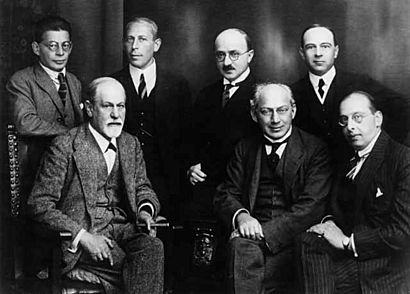
In 1912, Carl Jung published a book that showed his views were different from Freud's. Jung called his system analytical psychology. To protect psychoanalysis, Freud formed a "Secret Committee" of loyal followers. Jung resigned as president of the International Psychoanalytical Association in 1914.
Another follower, Otto Rank, also later left the group. This happened after he published his book The Trauma of Birth in 1924. Rank eventually moved to the United States. His ideas influenced new therapists there. Freud's daughter, Anna Freud, joined the Committee after Rank left.
Psychoanalysis Grows Worldwide
After the International Psychoanalytical Association was founded in 1910, psychoanalysis grew. Societies, training centers, and clinics were set up around the world. International meetings were held regularly after World War I.
In 1910, the Berlin Psychoanalytic Society was founded. They later opened the Berlin Psychoanalytic Institute and a clinic in 1920. These places offered free treatment and child analysis. They also set standards for training psychoanalysts.
In Russia, Freud's works were translated early. The Russian Psychoanalytic Society even received government support for a while. But this support ended in 1924 when Joseph Stalin came to power. Psychoanalysis was then seen as against their ideas.
In Britain, Ernest Jones founded the London Psychoanalytic Society in 1913. He later founded the British Psychoanalytical Society in 1919. He also helped establish the Institute of Psychoanalysis and the London Clinic of Psychoanalysis.
Other psychoanalytic groups and institutes were set up in Vienna, Budapest, Switzerland, France, Italy, the Netherlands, Norway, and Palestine.
Freud attended his last Congress in Berlin in 1922. By this time, his speech was affected by jaw cancer. He kept up with the movement through letters and meetings of his Secret Committee.
Escaping from Nazism
In 1933, the Nazi Party took power in Germany. They burned many books, including Freud's. Freud famously said, "What progress we are making. In the Middle Ages they would have burned me. Now, they are content with burning my books."
Freud did not want to leave Vienna, even after Nazi Germany took over Austria in 1938. But when his daughter Anna was arrested and questioned by the Gestapo, he finally agreed to leave. Ernest Jones helped him get permission to move to Britain. Many people, including American diplomats, also helped Freud.
Freud's family members left Vienna in stages. Freud, his wife Martha, and daughter Anna left Vienna on June 4, 1938. They traveled by train to Paris and then to London. They arrived in London on June 6.
Many famous people visited Freud in London. These included Salvador Dalí and Virginia Woolf. Freud was also elected a Foreign Member of the Royal Society. Sadly, Freud's four elderly sisters who stayed in Vienna were later killed in Nazi concentration camps.
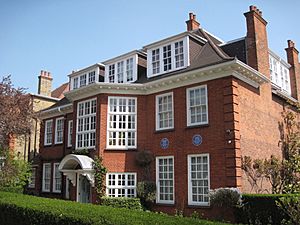
Freud's new home in London was at 20 Maresfield Gardens. His son, Ernst, designed changes to the house. The study was made to look like his old office in Vienna. Freud continued to see patients there. He also worked on his last books, Moses and Monotheism and An Outline of Psychoanalysis.
His Final Days
By September 1939, Freud's jaw cancer caused him great pain. It could not be operated on. On September 21 and 22, his doctor gave him medicine to ease his suffering. Sigmund Freud died on September 23, 1939, at age 83.
Three days later, Freud's body was cremated in London. His ashes were placed in a special urn at the Golders Green Crematorium. The urn was an ancient Greek pot that Freud had received as a gift. After his wife Martha died in 1951, her ashes were also placed in the urn.
Freud's Key Ideas
Freud developed techniques like free association. He also discovered transference, which became central to therapy. He believed that analyzing dreams could reveal hidden wishes. Based on this, he created his theory of the unconscious mind. He also developed a model of the mind with the id, ego, and super-ego.
Today, psychoanalysis is still important in psychology and psychotherapy. It has also influenced many other areas of culture.
The Unconscious Mind
The idea of the unconscious mind was very important to Freud. He believed that many of our thoughts and feelings are hidden from us. These hidden thoughts still affect how we act.
Freud thought that unwanted thoughts are pushed out of our conscious mind. But they don't disappear; they stay in the unconscious. They can then reappear in different ways, like in dreams or slips of the tongue.
He described the unconscious in three ways:
- The dynamic perspective looks at how thoughts are pushed away from our conscious mind.
- The economic perspective focuses on how these hidden thoughts change and appear in dreams or everyday mistakes.
- The topographical perspective describes the unconscious as a system with its own rules.
Freud's first model of the mind had three parts:
- The System Ucs – the unconscious mind
- The System Pcs – the preconscious mind (thoughts that can easily become conscious)
- The System Cns – the conscious mind (our current thoughts)
Later, he introduced another model in his book The Ego and the Id (1923). This model included the id, ego, and super-ego. These parts are also connected to the unconscious. The id is like a pool of our basic instincts and desires. It's the main source of our mental energy. The id often conflicts with the ego and super-ego.
Id, Ego, and Super-Ego

Freud suggested that the human mind has three main parts: the Id, the Ego, and the Super-ego.
- The id is the part of your mind that wants immediate pleasure. It's like the little voice that says, "I want it now!" It's driven by basic needs and desires.
- The super-ego is your moral compass. It's like the voice that tells you what's right and wrong. It's based on rules you learned from your parents and society.
- The ego is the part that tries to balance the id's desires with the super-ego's rules. It's the rational part that helps you deal with the real world. The ego tries to find a way to satisfy your needs in a realistic and acceptable way.
When the ego feels overwhelmed, it might use "defense mechanisms." These are ways the mind protects itself. Examples include denial (pretending something isn't true) or repression (pushing thoughts out of mind). Freud compared the ego and id to a charioteer (ego) guiding horses (id). The horses provide the power, but the charioteer gives direction.
Thoughts on Religion
Freud believed that the idea of a powerful God came from our childhood need for a strong parent figure. He thought that religion was once important to control people's violent nature. But in modern times, he felt that reason and science could take its place.
He also saw religion as a way to manage the forces of life and death. Later in his life, Freud became less hopeful about the future of civilization.
Freud's Lasting Impact
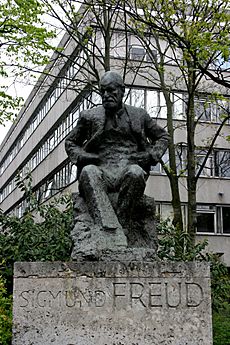
Freud's ideas have had a huge impact on the 20th century. His influence is often compared to that of Charles Darwin and Karl Marx. His work has changed how we think about ourselves and human culture.
Influence on Therapy
Freud's psychoanalytic system became very important in therapy. Many later types of therapy are based on his ideas. Even though these therapies use different methods, they all follow Freud's idea. They try to help patients by having them talk about their problems. This helps them understand and change their thoughts and behaviors.
Impact on Philosophy
Some thinkers have compared Freud to Marx. They see Freud as a revolutionary whose ideas changed how we think about the mind. His contributions to 20th-century thought are considered as important as Marx's contributions to 19th-century thought.
Major Works by Freud
Books
- 1891 On Aphasia
- 1895 Studies on Hysteria (with Josef Breuer)
- 1899 The Interpretation of Dreams
- 1901 On Dreams (a shorter version of The Interpretation of Dreams)
- 1904 The Psychopathology of Everyday Life
- 1905 Jokes and Their Relation to the Unconscious
- 1910 Five Lectures on Psycho-Analysis
- 1910 Leonardo da Vinci, A Memory of His Childhood
- 1915–17 Introductory Lectures on Psycho-Analysis
- 1921 Group Psychology and the Analysis of the Ego
- 1923 The Ego and the Id
- 1926 Inhibitions, Symptoms and Anxiety
- 1926 The Question of Lay Analysis
- 1927 The Future of an Illusion
- 1930 Civilization and Its Discontents
- 1933 New Introductory Lectures on Psycho-Analysis
- 1939 Moses and Monotheism
- 1940 An Outline of Psychoanalysis
See also
 In Spanish: Sigmund Freud para niños
In Spanish: Sigmund Freud para niños
- The Standard Edition of the Complete Psychological Works of Sigmund Freud
- Sigmund Freud Archives
- Freud Museum (London)
- Sigmund Freud Museum (Vienna)
- A Clinical Lesson at the Salpêtrière
- Afterwardsness
- Freudian slip
- Freudo-Marxism
- School of Brentano
- Hedgehog's dilemma
- Narcissism of small differences
- Hidden personality
- Histrionic personality disorder
- Psychoanalytic literary criticism
- Psychodynamics
- Saul Rosenzweig
- Signorelli parapraxis
- The Freudian Coverup
- Uncanny


